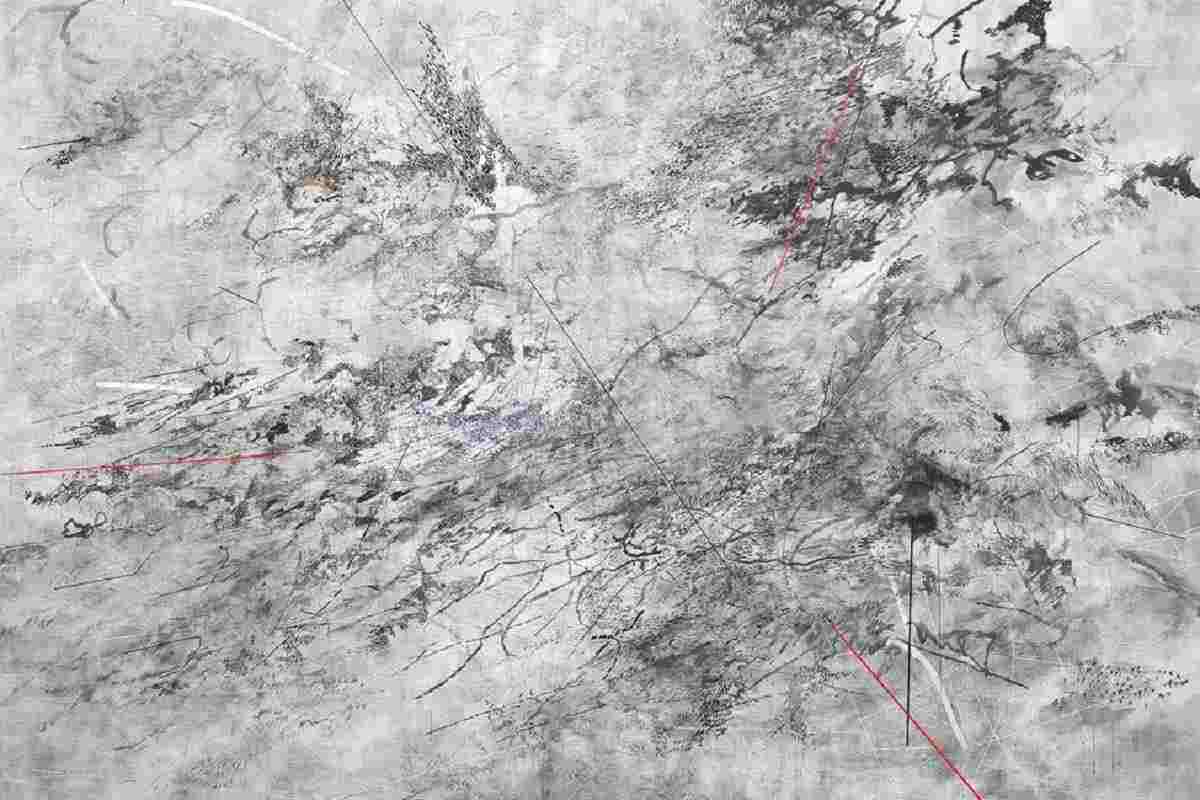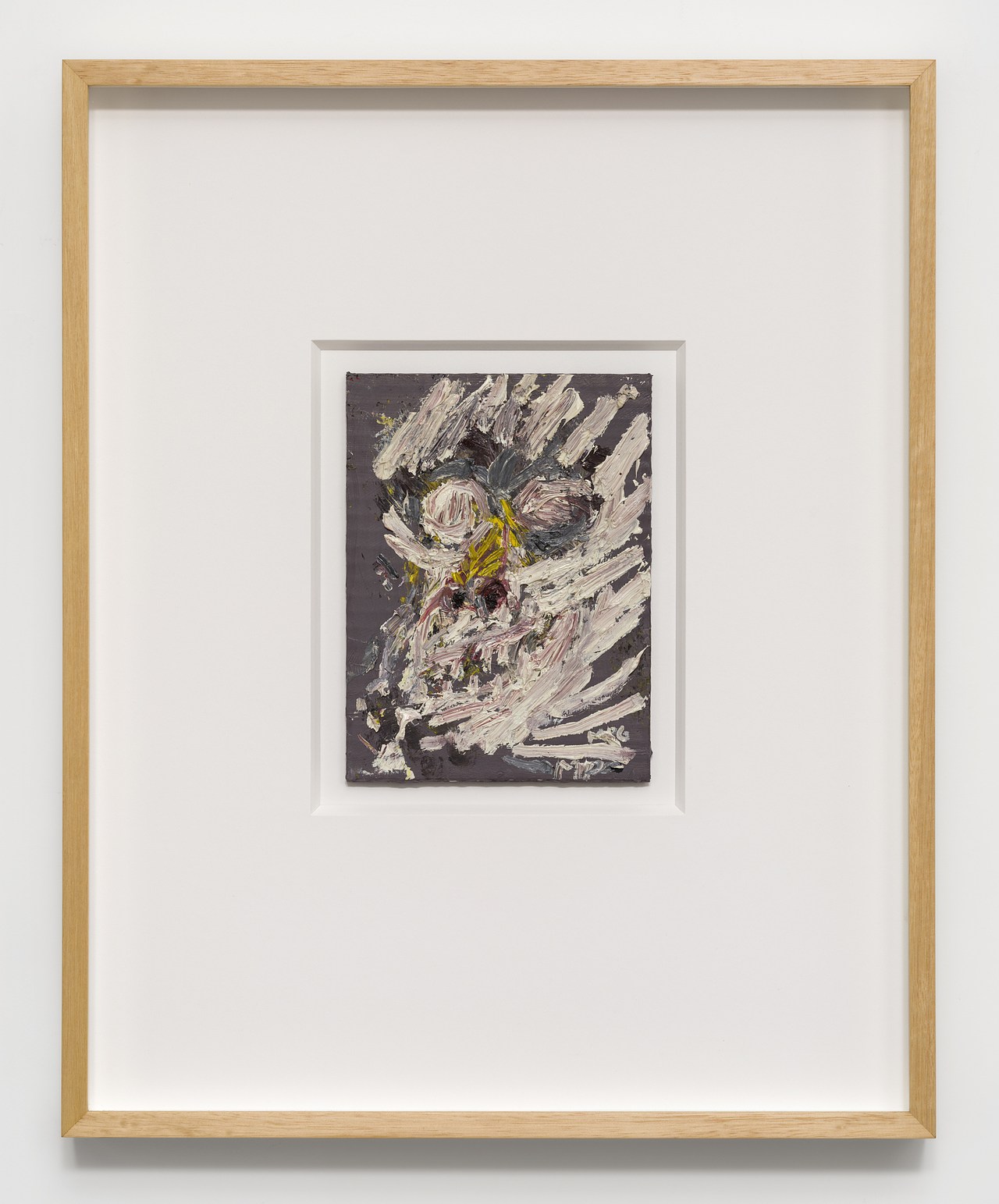
© » KADIST
Ellen Lesperance
Somewhere Along the Black Sea in the Distant North-East, or in Libya in the Furthest South, The Amazons – The Woman and the Girls Children – Exist Just Outside of the Range of Normal Human Experience

© » KADIST
Chris Johanson
Chris Johanson’s Untitled (Painting of a Man Leaving in Boat) (2010) pictures a canoe drifting toward an off-kilter horizon line, which demarcates the cobalt sea from the cerulean sky. An orange-haired figure, oar positioned in mid-stroke, looks ahead—whether toward an edge or an infinite expanse, it is impossible to tell. Echoing a trope that recurs in Greek epic poetry, transcendental painting, and current-day reality television, the character is alone with nature.

© » KADIST
Scott Reeder
Reeder’s works often start with language—and his Pasta Paintings are no different. After the phrase for the title came through his head, the artist set about trying to figure out how to make a mark with pasta. These paintings are the result, made using the pasta as something of a stencil, with the paint being applied after the noodles have been scattered on the painting’s blank surface.

© » KADIST
Julian Hoeber
Every work in Hoeber’s 2011 series Execution Changes is titled in alphanumeric code. The geometric pattern that composes each acrylic-on-panel painting is determined by a preordained ratio of 2 to 3. But even though a formulaic system determines the image’s structure, its surface is full of painterly effects.

© » KADIST
Mark Grotjahn
Drawing & Print (Drawing & Print)
This particular drawing, like many of Grotjahn’s works, presents a decentered single-point perspective. Unlike the traditional vanishing point, the rays here emanate from the surface’s middle and hover around an indefinite and impossible convergence. The resulting fluttering of the image’s sections animates the drawing in relationship to its named subject, the butterfly.

© » KADIST
Leslie Shows
Human Quarry is a large work on paper by Leslie Shows made of a combination of acrylic paint and collage. Both through its title and formally—through how the shapes in the composition resemble a mountain or natural formation—the piece relays us to a mineral quarry or a deep mining pit where materials are extracted. Interspersed among the block-like figures and rocky textures, we also see several human silhouettes, either cut-out, or as if they were whited out by a shining light, or lost in the shadows.

© » KADIST
Chris Johanson
Apartment on Cardboard (2000) is an exterior view of an abstracted apartment building. Viewers unwittingly become voyeurs, peering through the rectangles that stand for windows and observing the residents therein, who ponder questions both mundane and existential: “Where is Ron now?” and “What have I become?” The queries and characters are treated democratically—not judged, praised, or subjected to hierarchy. While their thoughts are specific, the painting captures a universal urban activity: looking across to the building next door and wondering about its residents, all the while knowing that they have probably looked over and wondered about us, as well.

© » KADIST
Chris Johanson
Chris Johanson’s paintings, sculptures, and installations break down everyday scenes and commonplace dramas into colorful forms; the darkest sides of humanity are invoked with humor. The works comment on subjects such as capitalism, consumerism, the art world, and therapy. The triptych I Am a Human, Abstract Foil, No Humans IV (2004) is a meditation on the cosmos.

© » KADIST
Federico Herrero
Federico Herrero’s energetic paintings reflect his experiences on the streets of his native San José, Costa Rica, and in the surrounding tropical landscape. Rooted in Central American folklore, politics, and culture, his works often move beyond the canvas onto the wall or into the streets. In Á rbol y Pelicao (Tree and Pelican, 2009), a tree with cartoonlike creatures drawn in pen beside it emerges from a field of bright swaths of color.

© » KADIST
Judy Chicago
Domes #1 represents a significant moment in Chicago’s career when her art began to change from a New York-influenced Abstract Expressionist style to one that reflected the pop-inflected art being made in Los Angeles. By 1968, the year she began creating Domes , the twenty-nine-year-old artist had moved from Chicago to Los Angeles, graduated from UCLA, and was part of a generation of artists whose work was characterized by of the masculine overtones of Southern California’s flourishing car culture. Inspired by new technologies in the auto manufacturing, these “Finish Fetish” artists appropriated industrial materials such as car paint or lacquer to create artwork with pristine finishes.
Chris Johanson
- location: Los Angeles, California
- year born: 1968
- gender: male
- nationality: American
- home town: San Jose, California
Mark Grotjahn
- location: Los Angeles, California
- year born: 1968
- gender: male
- nationality: American
- home town: Pasadena, California
Leslie Shows
- location: San Francisco, California
- year born: 1977
- gender: female
- nationality: American
Judy Chicago
- location: Belen, New Mexico
- year born: 1939
- gender: female
- nationality: American
- home town: Chicago, Illinois
Ellen Lesperance
Ellen Lesperance begins with archival footage of various activist events throughout history...
Federico Herrero
- location: San Jose, Costa Rica
- year born: 1978
- gender: male
- nationality: Costa Rican
- home town: San Jose, Costa Rica
Julian Hoeber
- location: Los Angeles, California
- year born: 1974
- gender: male
- nationality: American
- home town: Philadelphia, Pennsylvania
Scott Reeder
- location: Chicago, Illinois; Raleigh, NC
- year born: 1970
- gender: male
- nationality: American
- home town: Milwaukee, Wisconsin

© » HYPERALLERGIC
about 20 months ago (02/11/2024)
Harriet Korman’s Nonchalant Rigor Skip to content Harriet Korman, "Untitled" (2022), oil on canvas, 24 x 30 inches (all images courtesy the artist and Thomas Erben Gallery) Harriet Korman’s paintings are simultaneously rigorous and nonchalant...

© » ART CENTRON
about 23 months ago (12/11/2023)
Julie Mehretu's Masterpiece Breaks Records at Sotheby's - Artcentron Home » Julie Mehretu’s Masterpiece Breaks Records at Sotheby’s ART AUCTION Dec 11, 2023 Ξ Leave a comment Julie Mehretu’s Masterpiece Breaks Records at Sotheby’s posted by ARTCENTRON Julie Mehretu’s Masterpiece, Walkers With the Dawn and Morning sets a new record at auction...
-
1960-1969
Judy Chicago
1969Domes #1 represents a significant moment in Chicago’s career when her art began to change from a New York-influenced Abstract Expressionist style to one that reflected the pop-inflected art being made in Los Angeles...
-
2000-2009
Chris Johanson
2000Apartment on Cardboard (2000) is an exterior view of an abstracted apartment building...
Mark Grotjahn
Drawing & Print
2002(Drawing & Print) This particular drawing, like many of Grotjahn’s works, presents a decentered single-point perspective...
Chris Johanson
2004Chris Johanson’s paintings, sculptures, and installations break down everyday scenes and commonplace dramas into colorful forms; the darkest sides of humanity are invoked with humor...
Federico Herrero
2009Federico Herrero’s energetic paintings reflect his experiences on the streets of his native San José, Costa Rica, and in the surrounding tropical landscape...
-
2010-2019
Chris Johanson
2010Chris Johanson’s Untitled (Painting of a Man Leaving in Boat) (2010) pictures a canoe drifting toward an off-kilter horizon line, which demarcates the cobalt sea from the cerulean sky...
Julian Hoeber
2011Every work in Hoeber’s 2011 series Execution Changes is titled in alphanumeric code...
Scott Reeder
2013Reeder’s works often start with language—and his Pasta Paintings are no different...
